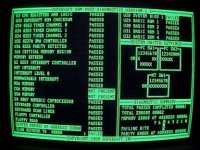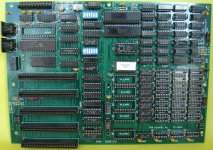Hello everyone,
I am working on a project to recreate the IBM 5150 in a more expanded modern form, similar to my other projects.
This project will be done by my daughter so I am using this as an educational CAD design example.
The reason why I am especially interested in this 5150 Personal Computer based design is because the 5150 has the cassette port capability which to me is very interesting to have and to do some testing with to see what's possible using tapes.
The cassette function is using pins on the PPI ports which in the 5160 and following are dedicated to other system functions.
So adding a cassette port to an XT is not an easy option either, though perhaps through some logic and BIOS switching additions but it would require at least modifying the PPI related circuits etc, I don't like hacking an existing PCB which is already a finished design.
The idea of having a cassette interface in a new PC compatible computer(except the PPI port differences) I simply find that very cool and retro, even though back in the day probably no one used this function as I have heard some comments about before. However from a retro enthousiast perspective today it's a lot more interesting.
The project will not be a copy of the design, I plan to integrate some other stuff as well such as a cassette monitor speaker circuit for some cool cassette saving noise and of course a normal full memory range of 640kb using SRAM and the 128k UMB RAM, single ROM chip, XT-IDE etc., and I will change the DMA timing logic as well.
After doing the XT projects, I must say it's rather interesting to look at the 5150 circuits since I can spot the differences right away.
They even used two delay ICs instead of the single one in the XT.
Recently I was looking at a Taiwanese Turbo XT clone mainboard and I was looking for the delay IC, which... isn't there. They created the CAS/RAS timing in another way. Probably using a sequence of gates of which the timing is pretty stable and known, or using some D flipflops.
Does anyone here perhaps know what the most modern BIOS would be that is compatible with a 5150 system which would still support to use a cassette in BASIC?
Also I wonder if anyone has ever seen a program that can store DOS files using a cassette tape.
I haven't seen such an example yet but that would be really fun and cool to try out.
Kind regards,
Rodney
I am working on a project to recreate the IBM 5150 in a more expanded modern form, similar to my other projects.
This project will be done by my daughter so I am using this as an educational CAD design example.
The reason why I am especially interested in this 5150 Personal Computer based design is because the 5150 has the cassette port capability which to me is very interesting to have and to do some testing with to see what's possible using tapes.
The cassette function is using pins on the PPI ports which in the 5160 and following are dedicated to other system functions.
So adding a cassette port to an XT is not an easy option either, though perhaps through some logic and BIOS switching additions but it would require at least modifying the PPI related circuits etc, I don't like hacking an existing PCB which is already a finished design.
The idea of having a cassette interface in a new PC compatible computer(except the PPI port differences) I simply find that very cool and retro, even though back in the day probably no one used this function as I have heard some comments about before. However from a retro enthousiast perspective today it's a lot more interesting.
The project will not be a copy of the design, I plan to integrate some other stuff as well such as a cassette monitor speaker circuit for some cool cassette saving noise and of course a normal full memory range of 640kb using SRAM and the 128k UMB RAM, single ROM chip, XT-IDE etc., and I will change the DMA timing logic as well.
After doing the XT projects, I must say it's rather interesting to look at the 5150 circuits since I can spot the differences right away.
They even used two delay ICs instead of the single one in the XT.
Recently I was looking at a Taiwanese Turbo XT clone mainboard and I was looking for the delay IC, which... isn't there. They created the CAS/RAS timing in another way. Probably using a sequence of gates of which the timing is pretty stable and known, or using some D flipflops.
Does anyone here perhaps know what the most modern BIOS would be that is compatible with a 5150 system which would still support to use a cassette in BASIC?
Also I wonder if anyone has ever seen a program that can store DOS files using a cassette tape.
I haven't seen such an example yet but that would be really fun and cool to try out.
Kind regards,
Rodney


